Ultimate Guide to a Thrilling Safari in the Serengeti
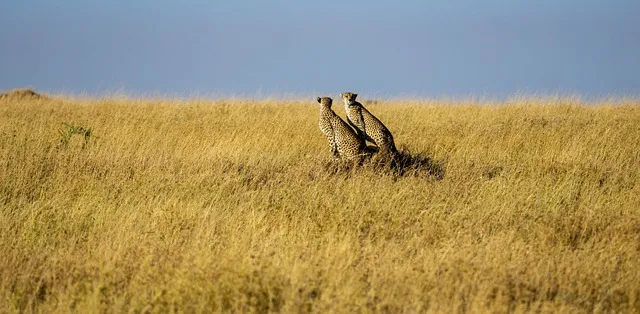
The Serengeti is not just a destination; it’s a living, breathing spectacle of nature’s grandeur. From the awe-inspiring Great Migration to the majestic Big Five, this park offers an unparalleled safari experience. In this guide, we will delve into the Serengeti’s diverse landscapes, explore its rich wildlife, and provide insights on the best times to visit for unforgettable encounters. We’ll also recommend complementary destinations like the Ngorongoro Crater, ensuring your Tanzanian adventure is complete with exceptional wildlife experiences and stunning scenery.
Executive Summary
This article;
- Provides an in-depth guide to Serengeti National Park, highlighting its vast landscapes, diverse wildlife, and the iconic Great Migration.
- Explores the park’s renowned wildlife, including the Big Five and the annual migration of wildebeest and other animals, showcasing the unique experiences available.
- 0ffers insights on the best times to visit Serengeti for optimal wildlife viewing and different seasonal highlights.
- Suggests additional destinations to visit in Tanzania, such as Ngorongoro Crater, Tarangire National Park, Lake Manyara, and Lake Victoria, to enhance your safari experience.
Video Overview: Safari in the Serengeti
Discover Serengeti National Park
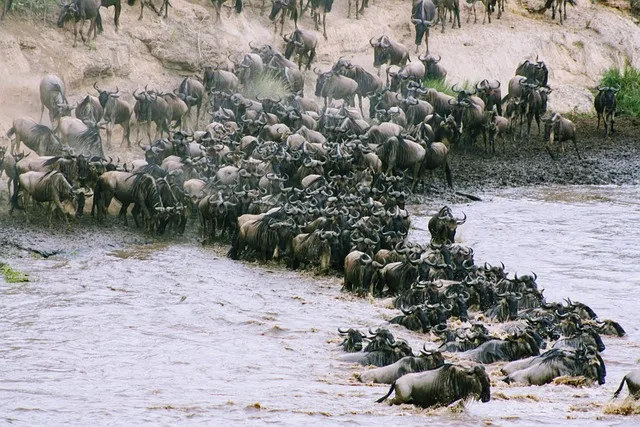
Serengeti National Park is an East Africa gem, spanning a staggering 14,763 km2 (5,700 sq mi) in northern Tanzania. The park is world-renowned for hosting the Great Wildebeest Migration, where over two million wildebeest, zebras, and gazelles traverse its grassland plains in search of fresh grazing. This natural spectacle is one of the most extraordinary wildlife events on the planet, attracting visitors from around the globe.
Beyond the migration, Serengeti National Park is home to the Big Five—lions, leopards, elephants, rhinos, and buffalo—as well as countless other species, including cheetahs, hyenas, and a rich variety of birdlife. The park’s diverse habitats, from open plains to riverine forests, create a stunning backdrop for unforgettable safari experiences.
Etymology and History
The name “Serengeti” is derived from the Maasai word “siringet,” meaning “the place where the land runs on forever.” The park’s history dates back to its establishment as a game reserve in 1951, with the formation of the Serengeti National Park Board of Trustees to grant strict protection. The park achieved international recognition following the publication of Bernhard Grzimek and his son Michael’s book and corresponding documentary “Serengeti Shall Not Die” in 1959. This created a social movement to protect the African wildlife and their habitats, promoting conservation efforts worldwide.
Today, the Serengeti is a UNESCO World Heritage Site, reflecting its cultural and natural significance.
Geography and Landscape
Serengeti National Park’s geography features expansive plains, rolling hills, and diverse ecosystems. At its core are vast, open grasslands that provide prime grazing grounds for migratory herds. The Mara River is a key feature in the northern part of the park, integral to the Migration. To the west, the terrain transitions into rugged landscapes and woodlands. The southeastern plains are drier, characterized by arid landscapes and volcanic features. These varied habitats, including river valleys and beautiful landscapes dotted with kopjes, make the Serengeti one of Africa’s most iconic and biologically rich regions.
Wildlife in the Serengeti
The Serengeti teems with incredible wildlife, including the famous Big Five – lions, leopards, elephants, buffalos, and rhinos – and the annual Great Migration, where millions of wildebeest, zebra, and other animals journey across the plains in search of food and water.
With so many animals and such an abundance of wildlife, every day in the Serengeti brings new and thrilling encounters.
The Big Five
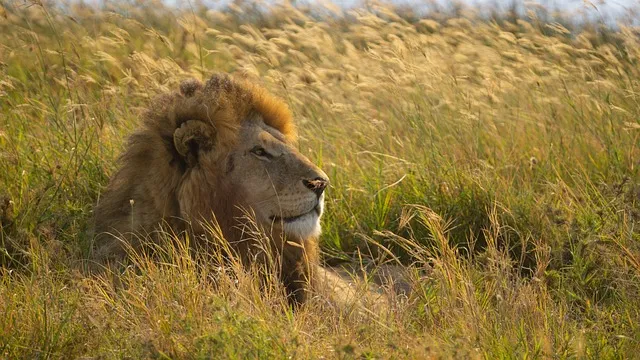
The Big Five is a term used to describe five of Africa’s most iconic and sought-after wildlife species. These animals include;
- Lions
- Leopards
- Elephants
- Buffalos
- Rhinos
African lions are known for their majestic manes, which can vary in color and size. The mane serves to make males look larger and may even reflect their state of health. Leopards, on the other hand, are elusive and agile predators. Visitors have a high chance of encountering these beautiful big cats resting on tree branches or stealthily stalking prey in the Serengeti.
African elephants, the largest land animals on Earth, roam the Serengeti in large herds, utilizing a variety of forage and exhibiting their typical social behavior. Buffalos, on the other hand, are known for their strength and determination. They are also known to form massive herds that can number in the thousands. Lastly, the black rhinoceros, once abundant in the Serengeti, has seen a decline in its population due to poaching. However, conservation efforts have helped the population slowly recover, with fewer than 70 individuals now residing in the park.
The Great Migration
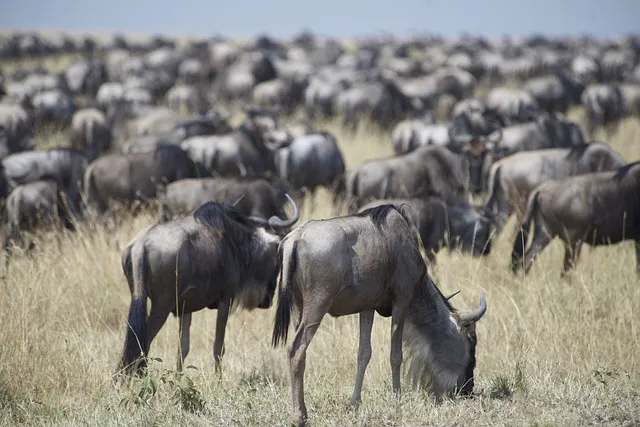
The Great Migration, also known as the wildebeest migration or the Serengeti Migration, is an annual event in which millions of wildebeest, zebra, and other animals migrate across the Serengeti in search of food and water. This awe-inspiring spectacle typically occurs from late June to August or early September and is triggered by the seasonal rains. The best areas to witness the Great Migration are:
- The short-grass plains and their granite kopjes in the south
- The Seronera Valley
- The Western Corridor
- The far north of the park where it meets the Mara in Kenya.
The Wildebeest Migration offers a unique opportunity to observe massed wildebeest herds and thrilling predator action. As the herds move across the plains, they are closely followed by lions, leopards, and other predators, who take advantage of the abundance of prey.
Planning Your Serengeti Safari
Proper planning for your Serengeti safari guarantees an optimal experience. Knowing the best time to visit and what to pack will help you make the most of your adventure in this incredible region.
Best Time to Visit
The best times to visit Serengeti National Park depend on what you want to experience:
Dry Season (Late June to October)
- Wildlife Viewing: Optimal for spotting wildlife, as animals gather around water sources and the sparse vegetation provides clear visibility.
- Great Migration: You can witness the dramatic river crossings of huge herds of wildebeest and other animals as they move from the Serengeti to the Maasai Mara in Kenya.
- Weather: Generally sunny and dry, with minimal rainfall and pleasant temperatures.
Green Season (November to May)
- Calving Season: From January to March, you can see the calving of migrating herds, with many newborns and predator interactions.
- Bird Watching: The rainy season (March to May) brings migrant bird species, making it a prime time for bird enthusiasts.
- Weather: The landscape becomes lush and green, and while there are occasional rains, the park is less crowded and offers a different perspective on its beauty.
What to Pack
Packing appropriate items for a Serengeti safari enhances comfort and enjoyment during the trip. Some must-haves include:
- A safari shirt (preferably synthetic for comfort)
- Comfortable and sturdy shoes
- Lightweight and breathable clothing
- Sunscreen and insect repellent
- A hat and sunglasses for sun protection
- Binoculars for wildlife viewing
- A camera or smartphone for capturing memories
- Personal toiletries and medications
- A reusable water bottle
- Snacks for the journey
Make sure to check the weather forecast and pack accordingly. Dressing in layers is advisable, as temperatures may fluctuate throughout the day. By being prepared with the right clothing and gear, you will be able to fully immerse yourself in the Serengeti safari experience.
Accommodation Options in the Serengeti
In the Serengeti, you’ll find a variety of accommodation options to suit every traveler’s preferences and budget, from luxury lodges to tented camps. Whether you’re seeking the ultimate in comfort and indulgence or a more rustic and immersive experience, the Serengeti has something to offer everyone.
Luxury Lodges
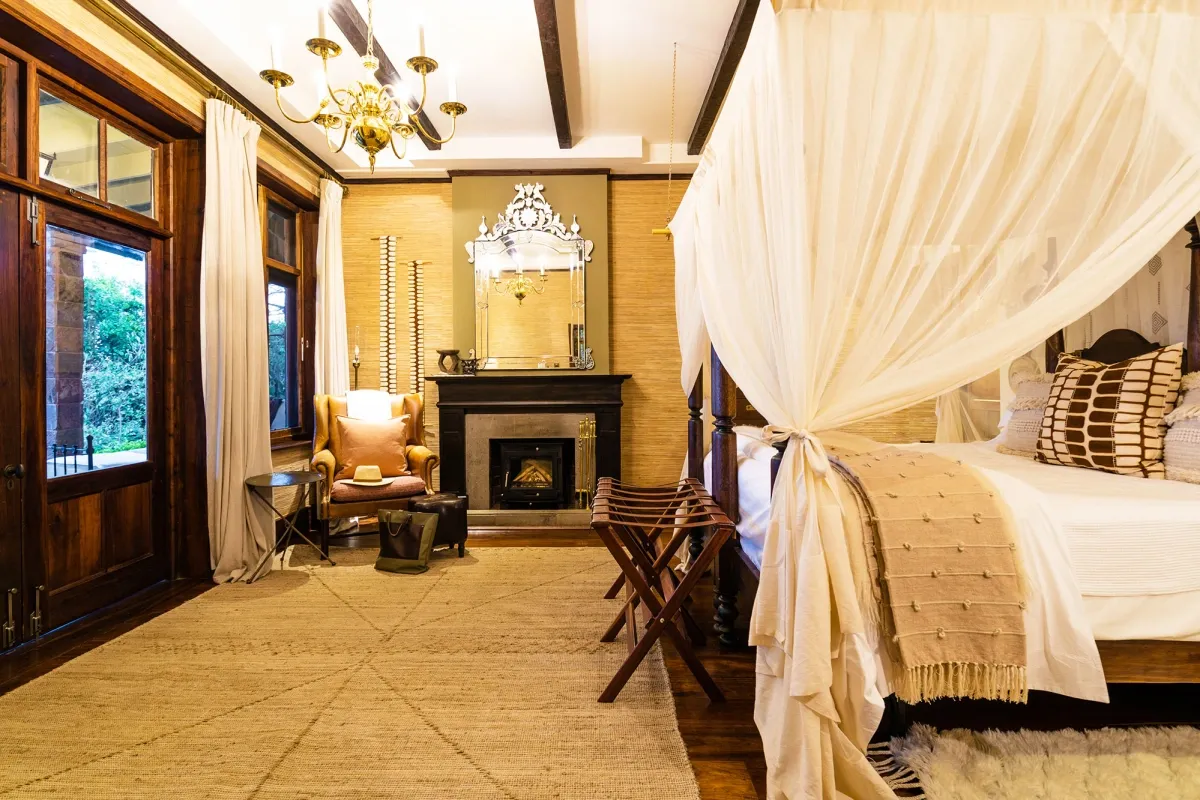
Luxury lodges in the Serengeti provide high-grade amenities and services for a lavish safari experience. Some of these opulent properties include:
- Singita Sasakwa Lodge
- Mwiba Lodge
- Namiri Plains
- Sanctuary Kichakani Camp
- Bushtops
These lodges provide everything from sumptuous accommodations and gourmet dining to guided game drives and spa treatments, ensuring that your every need is catered to.
The cost of residing at a luxury lodge in the Serengeti varies between $500 and $2,000 per person per night, depending on the particular lodge and season. By choosing a luxury lodge, you’re not only investing in a memorable stay but also supporting the local economy and conservation efforts.
Tented Camps
For adventure seekers desiring a genuine safari experience, tented camps strike a balance between comfort and engagement with the Serengeti’s picturesque environment. Top-rated tented camps in the region include &Beyond Klein’s Camp, Mawe Camp, and Serengeti Under Canvas. These camps provide comfortable tents with beds, en-suite bathrooms, dining facilities, and knowledgeable guides who take guests on thrilling game drives.
The cost for tented camps in the Serengeti usually ranges from $200 to $1,000 per person per night, based on the level of luxury and provided amenities. By choosing a tented camp, you’ll have the opportunity to connect with nature and experience the Serengeti in a truly unique and unforgettable way.
Experiencing a Serengeti Safari
There are several ways to experience the Serengeti, each offering its own unique perspective and thrill. Whether you’re exploring the vast plains on a game drive, soaring above the landscape on a hot air balloon safari, or immersing yourself in local culture, your Serengeti safari will be a wonderful experience.
Game Drives
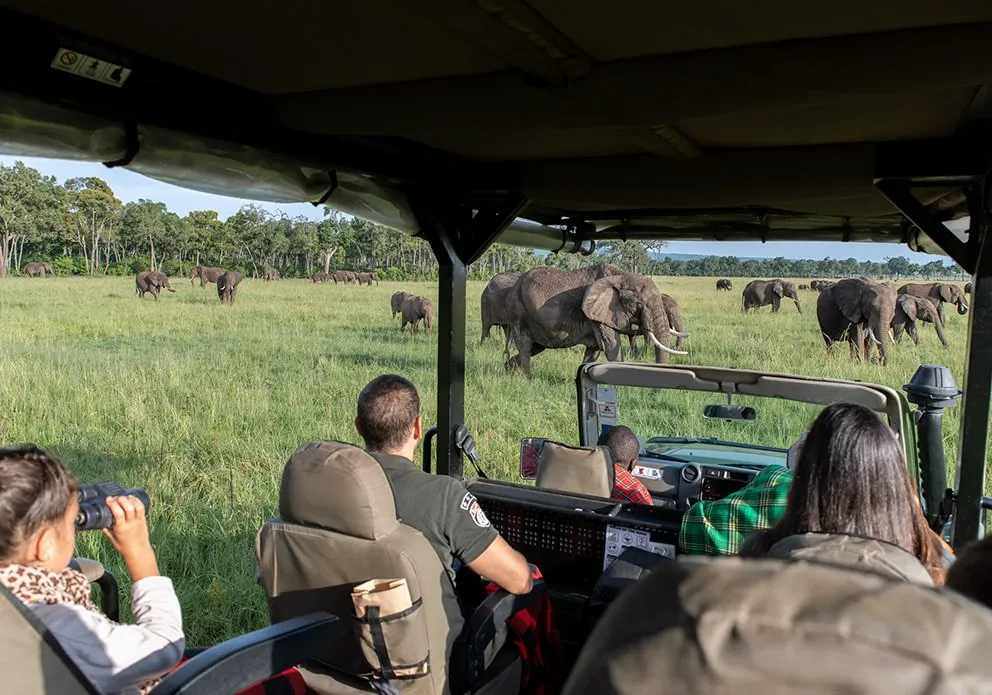
Safari drives in the Serengeti offer a superb opportunity to traverse through the park and observe wildlife at close quarters. Early mornings, just before 6:00am, are the best times for game drives, as this is when the animals are most active and you have a higher chance of witnessing exciting predator-prey interactions. The vehicles used for game drives are typically open 4×4 safari vehicles, such as Land Cruisers or Land Rovers, allowing for excellent visibility and photo opportunities.
Safety is of utmost importance during game drives in the Serengeti. Guides adhere to strict protocols, ensuring that visitors remain in the vehicle at all times unless instructed otherwise, and maintain a safe distance from the animals. A typical game drive lasts about 2-3 hours, providing ample time to marvel at the park’s incredible biodiversity and observe the animals in their natural environment.
Hot Air Balloon Safaris

A hot air balloon safari provides a distinctive and thrilling view of the Serengeti. Floating high above the plains, you’ll have the opportunity to take in the breathtaking landscapes and observe the wildlife from a bird’s-eye view. The best time of year for hot air balloon safaris in Serengeti National Park is during the dry season, when the weather is generally clear and stable, providing optimal flying conditions.
The approximate cost of a hot air balloon safari in the Serengeti is $599 per person, a price that justifies the memorable experience.
P.S: Hot air balloon safaris follow safety measures such as wearing suitable attire and footwear, carrying a light windproof jacket for chilly mornings, and adhering to the guidance of skilled balloon pilots.
Cultural Experiences in the Serengeti
Beyond the remarkable wildlife and stunning landscapes, the Serengeti provides a variety of cultural experiences that enhance your safari journey. Trips to Maasai villages and participation in traditional performances allow you to engage in local culture and comprehend the lifestyle of the region’s inhabitants.
Maasai Village Visits
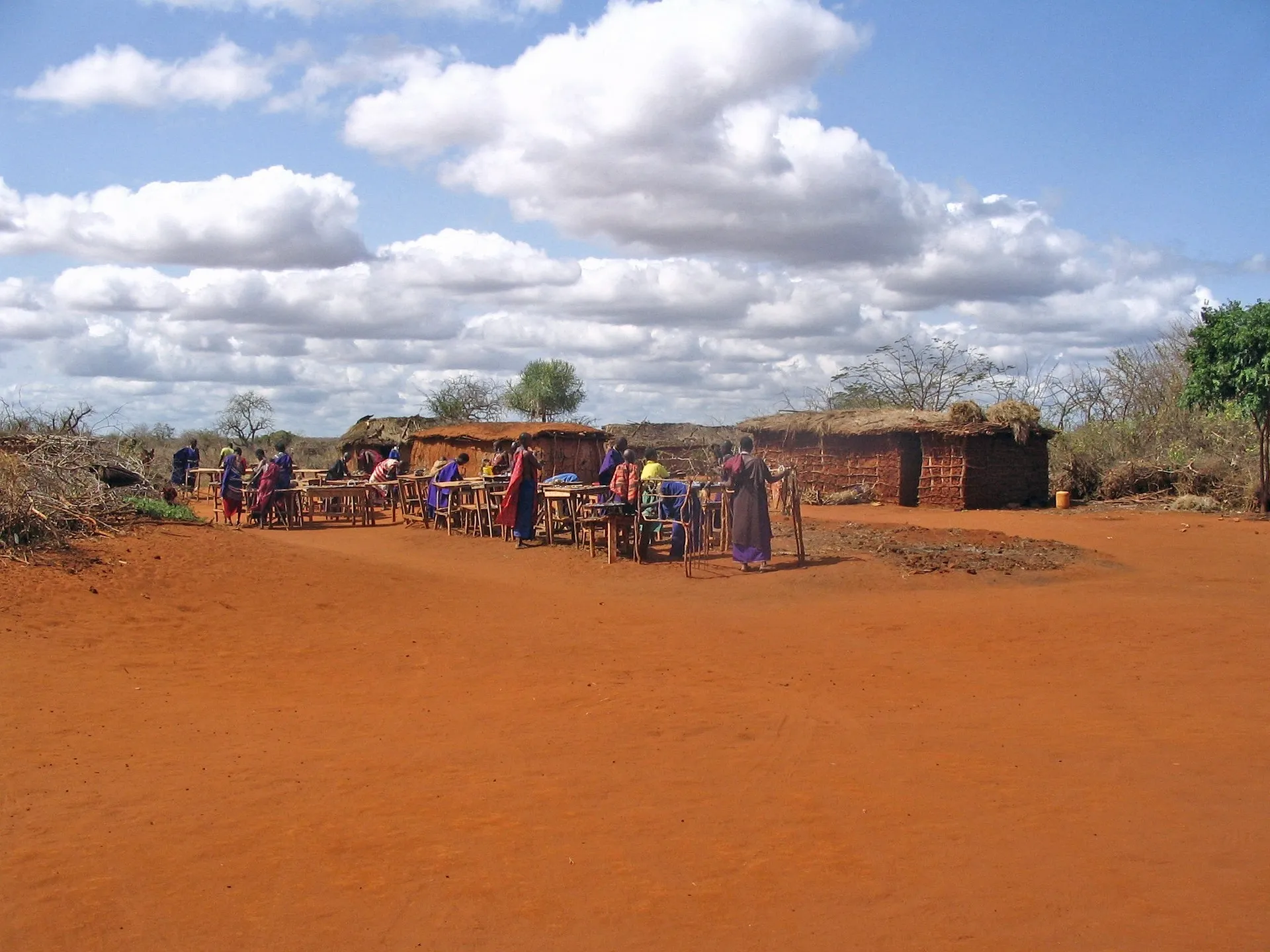
The Maasai people have a long history in the Serengeti, herding their cattle in the region for thousands of years. Despite facing challenges and forced relocations due to the establishment of hunting grounds and game reserves, they remain a proud and nomadic warrior race. By visiting a Maasai village, you will gain insight into their unique culture, traditions, and way of life.
During a visit to a Maasai village, observing cultural norms and engaging respectfully with the community is significant. This includes asking for permission before taking photos or videos, participating in cultural activities, and engaging with the village elders and women. By choosing to visit a Maasai village, you’ll not only gain a unique cultural experience but also support the local community and contribute to the preservation of their traditional way of life.
Traditional Performances
Traditional music and dance performances in the Serengeti celebrate the region’s vibrant cultural legacy. These performances often involve traditional attire, intricate choreography, and the vibrant sounds of local music, providing a unique opportunity to immerse yourself in the traditions of the Serengeti.
In addition to the captivating performances, you may also have the opportunity to learn traditional skills, such as hunting, milking domestic animals, and cooking traditional foods. These experiences provide a deeper understanding of the local culture and allow you to connect with the community in a meaningful way.
Combining Your Serengeti Safari with Other Destinations
To prolong your Tanzanian journey, you could combine your Serengeti safari tours with trips to other local attractions like the Ngorongoro Crater and Tarangire National Park. These destinations offer unique wildlife experiences and stunning landscapes that complement your Serengeti journey.
Ngorongoro Crater
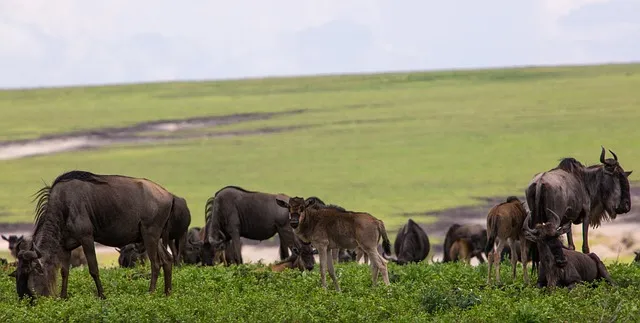
A UNESCO World Heritage Site, the Ngorongoro Crater possesses a distinct ecosystem brimming with varied wildlife. Formed when a large volcano erupted and collapsed on itself, the crater today is home to a wide range of animal species, including the Big Five. The crater’s dense evergreen forests, open grasslands, and varied habitats also attract a variety of bird species, making it a paradise for birdwatchers.
Visiting the Ngorongoro Crater, located within the Ngorongoro Conservation Area, offers the opportunity to witness a different side of Tanzania’s incredible wildlife and landscapes.
Tarangire National Park
Though less renowned compared to other parks, Tarangire is a concealed jewel offering a distinctive safari experience. The park is known for:
- Its large elephant population
- Striking baobab trees
- Tree-climbing lions
- Long-necked gerenuk
- Fringe-eared oryx
Lake Manyara
Lake Manyara, nestled at the base of the Great Rift Valley escarpment, is celebrated for its diverse ecosystems and vibrant birdlife. The lake attracts a multitude of bird species, including flamingos, which create stunning visual displays. The park’s lush forests and soda lake also support a variety of wildlife, such as giraffes, elephants, and the elusive tree-climbing lions. Adding Lake Manyara to your itinerary provides a comprehensive Tanzanian safari experience, showcasing the country’s rich natural beauty and diverse habitats.
Lake Victoria
Lake Victoria, Africa’s largest lake and the world’s second-largest freshwater lake, is a significant addition to any Tanzanian safari itinerary. Located on the border of Tanzania, Uganda, and Kenya, it offers a stunning contrast to the inland safaris. The lake is renowned for its rich biodiversity, including numerous fish species such as the Nile perch and cichlids. Its surrounding wetlands and islands are home to a variety of bird species, including the elusive shoebill stork. The vibrant local communities around the lake, including traditional fishing villages, provide unique cultural experiences. A visit to Lake Victoria adds an enriching dimension to your journey, blending natural beauty with cultural exploration.
Summary
A Serengeti safari is a truly unforgettable adventure, offering the chance to witness some of the world’s most incredible wildlife, breathtaking landscapes, and rich cultural experiences. From the awe-inspiring Great Migration to the hidden gems of the Ngorongoro Crater and Tarangire National Park, the Serengeti is a destination that promises to leave you with memories that will last a lifetime.
Frequently Asked Questions
In this section, we answer some of your most frequently asked questions about safaris in the Serengeti.
How much does Serengeti safari cost?
Booking a one-week safari in Serengeti National Park with TourRadar can cost between $2,500-$7,500 USD, so don’t miss out on this amazing adventure!
Is the Serengeti the best safari?
The Serengeti National Park is huge, with over five times the land area of the Masai Mara! If you’re looking for a truly spectacular African safari, then look no further than the Serengeti – it’s an unforgettable experience.
How many days do you need in Serengeti safari?
Explore the Serengeti with a minimum of four days and three nights for the best adventure! With this time frame, you will have plenty of opportunities to experience all the different parts of Northern Serengeti.
Is Serengeti better than Masai Mara?
Experience both the wonders of Masai Mara and Serengeti! They are part of the same cross-border ecosystem and both offer incredible landscapes and wildlife. You can’t go wrong with either destination!
What is the best month to visit the Serengeti?
Experience a spectacular safari no matter when you visit the Serengeti, but the best months to experience its wildlife density are January to February and June to October!
